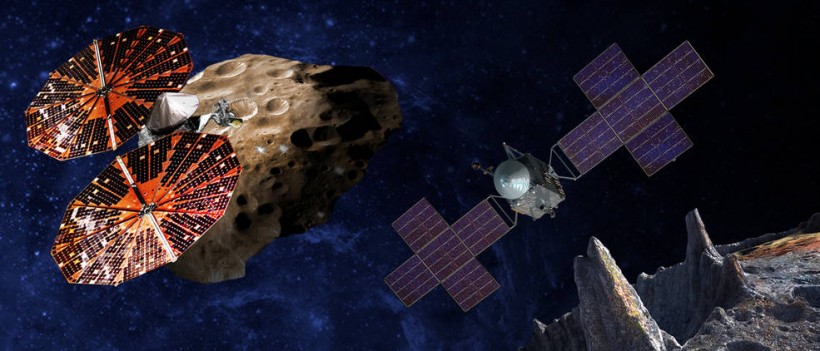NASA's Lucy mission has obtained its first glimpses of four Jupiter Trojan asteroids, which will help choose exposure times for close-up examinations in the future. Lucy is on a 12-year voyage to investigate nine Jupiter Trojans and two main belt asteroids, making it the first mission to do so.
The four asteroid images obtained by the Lucy mission are crucial for analyzing the composition, structure, and orbital characteristics of these celestial bodies. Such investigation will help to enhance understanding of the Trojan asteroids and the origination of the Solar System.

An artist’s conception of the Lucy spacecraft flying by the Trojan Eurybates – one of the six diverse and scientifically important Trojans to be studied. Trojans are fossils of planet formation and so will supply important clues to the earliest history of the solar system.
Four Jupiter Trojan Asteroids Captured In a Photograph For the First Time
Between March 25 and 27, 2023, Lucy photographed four Jupiter Trojan asteroids using its highest resolution camera called L'LORRI, SciTech Daily reported. The camera captured its first shots of Eurybates, Polymele, Leucus, and Orus, with each image taken from different orientations as the camera turned to target each asteroid.
The length of observation also varied across the images, with Eurybates photographed for 6.5 hours, Polymele for 2.5 hours, Leucus for 2 hours, and Orus for 10 hours, aligned with their rotation periods.
.@NASA's Lucy mission has caught views of four of the asteroids it will visit!
— NASA Marshall (@NASA_Marshall) April 13, 2023
The asteroids are still more than 330 million miles away. The spacecraft will fly by these asteroids in 2027 and 2028.
Learn more HERE>> https://t.co/mibJFCan5q pic.twitter.com/7vqZmmVhRI
These images represent the starting point for a planned series of observations, aimed at exploring how Trojan asteroids reflect light from angles beyond what is observable from the Earth. While the images show the asteroids as single points of light against a backdrop of distant stars, the data will guide the team in choosing exposure times for future close-up observations.
Overall, Lucy's first views of these four asteroids are a significant step forward in understanding the nature of Jupiter Trojan asteroids. Through these observations, scientists can learn more about their physical characteristics and uncover clues about the early solar system's formation.
READ ALSO: NASA's Lucy Mission Going to Space Soon to Probe Jupiter's Weird Trojan Asteroids
Lucy Spacecraft on a Voyage To Study the Trojan Asteroids for the First Time
According to NASA, the Lucy mission will be the first space mission to study the Trojan asteroids, which are swarms of asteroids that orbit the Sun in two groups clustered around Jupiter's Lagrange points. These primitive bodies are thought to be remnants of the primordial material that formed the outer planets, and they hold vital clues to understanding the history of the Solar System.
The Lucy mission launched in October 2021 and is set to complete a 12-year journey to eight different asteroids, including a Main Belt asteroid and seven Trojans, four of which are members of binary systems. Last October 2022, Lucy shared some photos of the Moon as it pass by Earth's natural satellite.
Lucy's complex path will take it to both groups of Trojans, providing the first close-up view of all three major types of bodies in the swarms, including the C-, P-, and D-types.
The P- and D-type Trojans resemble those found in the Kuiper Belt, while the C-types are found mostly in the outer parts of the Main Belt. All of the Trojans are considered to be rich in black carbon compounds and, under an insulating coating of dust, in water and other volatile chemicals.
RELATED ARTICLE: Dinkinesh: NASA's Lucy Mission Names First Asteroid Target It Will Encounter Later This Year
Check out more news and information on Lucy Mission in Science Times.














